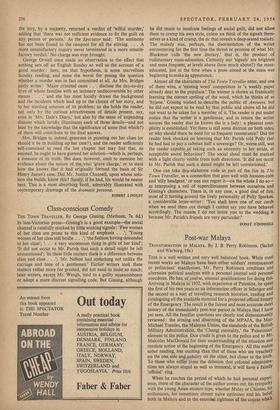No Antimony in the Cesspool
HOW CHARLES BRAVO DIED, By Yseult Bridges. (Jarrolds, 21s.) IN 1876, the high afternoon of the Victorian day (income tax, 2nd in the £; divorces, a few hundred in the year), Charles Brava, a young barrister, four months married to a rich and beautiful wife with a lady-companion and a `past,' died of poisoning by antimony. During the fifty-four hours that he was conscious between the time when, in unknown circumstances, he swallowed the poison, and his death, he neither appeared surprised at being poisoned, nor accused himself or anyone else of administering it. At the inquest an open verdict was returned, but as a result of public suspicion falling upon the wife and the companion (who were assailed with some of the most ferocious anonymous letters ever written) a second inquest was held, that developed into a pseudo-trial of the two women; after twenty-three days the jury, by a majority, returned a verdict of 'wilful murder,' adding that 'there was not sufficient evidence to fix the guilt on any person or persons.' As the Spectator said : 'The antimony has not been found in the cesspool for all the stirring. . . . A more unsatisfactory inquiry never terminated in a more unsatis- factory verdict.' No charge was ever brought.
George Orwell once made an observation to the effect that nothing sets off an English Sunday so well as the account of a good murder : here, on that hypothesis, is some marvellous Sunday reading, and none the worse for posing the question whether a murder was in fact committed at all. As Mrs. Bridges justly writes: 'Major criminal cases . . . disclose the day-to-day lives of whole families with an intimacy undiscoverable by other means . . . ,' and she has most lucidly drawn the background and the incidents which lead up to the climax of her story, and to her startling solution of its problem; so she holds the reader, not only by the curious attractiveness of details present, say, even in 'Mrs. Dale's Diary,' but also by the sense of impending disaster which luridly illuminates each of those details—and not least by the knowledge that the significance of some (but which?) of them will contribute to the final answer.
Mrs. Bridges is, indeed, generous in pointing out her clues (or should it be in building up her case?), and the reader sufficiently self-contained to read the last chapter last may feel that, so assisted, he ought to have guessed her solution—which is, perhaps, a measure of its truth. She does, however, omit to mention her evidence about the nature of the, vital 'grave charge,' or to state how she knows that it had originally formed the basis of Sir Henry James's case. Did Mr. Justice Channell, upon whose solu- tion she builds, know this? Surely, if he had, his would be nearer hers. This is a most absorbing book, admirably illustrated with contemporary drawings of the dramatis personce.
ROBERT LINDLEY



































 Previous page
Previous page